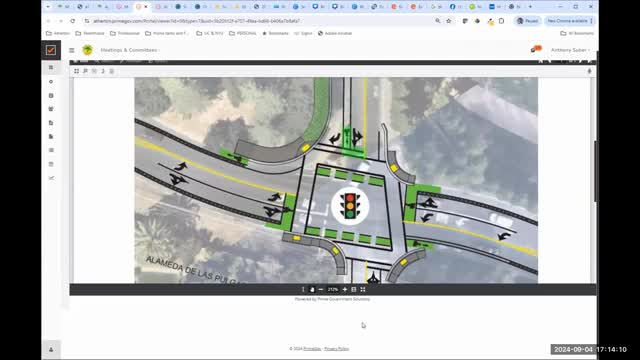Roundabout proposal sparks debate over safety and costs
September 13, 2024 | Atherton Town, San Mateo County, California
This article was created by AI summarizing key points discussed. AI makes mistakes, so for full details and context, please refer to the video of the full meeting. Please report any errors so we can fix them. Report an error »

During a recent government meeting, officials engaged in a robust discussion regarding the potential implementation of a roundabout as an alternative to traditional traffic lights. The conversation highlighted the safety benefits of roundabouts, with one participant noting that even a smaller roundabout would still be significantly safer than traffic lights, which have a fatality rate ten times higher and a higher incidence of injury accidents.
Concerns were raised about the costs associated with the roundabout, particularly the estimated $600,000 allocated for sidewalks and ramps. Questions emerged about whether similar expenses for traffic lights were being considered in the cost comparison. Participants emphasized the need for a thorough evaluation of these costs, suggesting that the roundabout design could be adjusted to reduce expenses without compromising safety.
The discussion also touched on the implications for cyclists, with some officials expressing apprehension about the safety of bike lanes in conjunction with roundabout traffic flow. One member pointed out that cyclists might not adhere to designated crossing protocols, potentially leading to dangerous interactions with vehicles. Despite these concerns, others argued that with proper markings and slower vehicle speeds, the roundabout could provide a safer environment for all road users.
The meeting concluded with a consensus on the need for further analysis of the roundabout's design and its impact on both traffic flow and cyclist safety. Participants agreed that any financial decisions should be carefully considered, ensuring that funds are allocated effectively to meet the community's needs.
Concerns were raised about the costs associated with the roundabout, particularly the estimated $600,000 allocated for sidewalks and ramps. Questions emerged about whether similar expenses for traffic lights were being considered in the cost comparison. Participants emphasized the need for a thorough evaluation of these costs, suggesting that the roundabout design could be adjusted to reduce expenses without compromising safety.
The discussion also touched on the implications for cyclists, with some officials expressing apprehension about the safety of bike lanes in conjunction with roundabout traffic flow. One member pointed out that cyclists might not adhere to designated crossing protocols, potentially leading to dangerous interactions with vehicles. Despite these concerns, others argued that with proper markings and slower vehicle speeds, the roundabout could provide a safer environment for all road users.
The meeting concluded with a consensus on the need for further analysis of the roundabout's design and its impact on both traffic flow and cyclist safety. Participants agreed that any financial decisions should be carefully considered, ensuring that funds are allocated effectively to meet the community's needs.
View full meeting
This article is based on a recent meeting—watch the full video and explore the complete transcript for deeper insights into the discussion.
View full meeting
